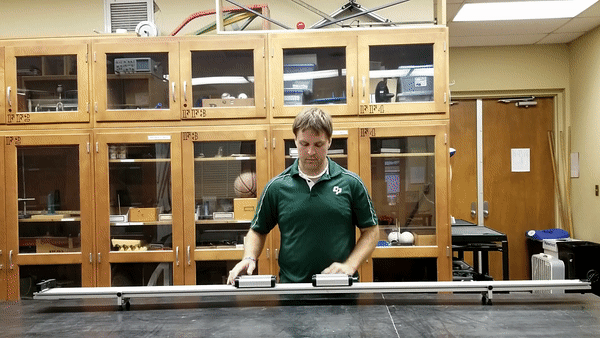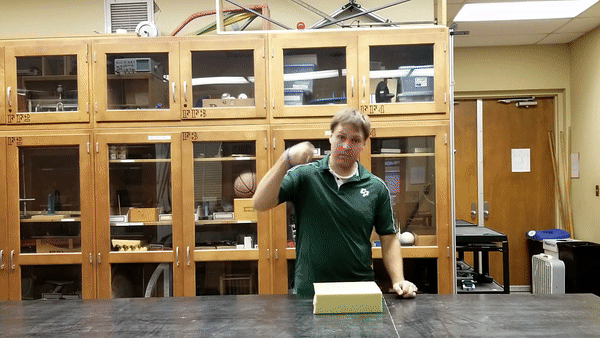Physics 141 Weeks 9 & 10
Collisions
"Happy" and "Sad" Balls
 Two rubber balls with different coefficients of restitution are used to model both elastic (“Happy” Ball) and inelastic (“Sad” Ball) collisions.
Two rubber balls with different coefficients of restitution are used to model both elastic (“Happy” Ball) and inelastic (“Sad” Ball) collisions.
Collisions with Carts
 Two Pasco carts are set on a linear track. Their magnets have been arranged so that both elastic and inelastic collisions can be demonstrated. This is a good “Think, Predict, Verify, Explain” opportunity for students, and can be approach qualitatively with “momentum rectangles”
Two Pasco carts are set on a linear track. Their magnets have been arranged so that both elastic and inelastic collisions can be demonstrated. This is a good “Think, Predict, Verify, Explain” opportunity for students, and can be approach qualitatively with “momentum rectangles”
Pendulum Collider
 Happy and sad balls are swung into a board at about 45 degrees. The happy ball will knock over the board but the sad ball will not. This is a great demonstration to discuss why cars are designed to crumple in collisions instead of bounce.
Happy and sad balls are swung into a board at about 45 degrees. The happy ball will knock over the board but the sad ball will not. This is a great demonstration to discuss why cars are designed to crumple in collisions instead of bounce.
Newton's Cradle
 5 rigid spheres are suspended next to each other. When one (or some) are pulled outwards and released, they collide with the rest shooting some outwards. Challenge your students by asking why if 2 balls go in, one traveling at twice the velocity can't come out.
5 rigid spheres are suspended next to each other. When one (or some) are pulled outwards and released, they collide with the rest shooting some outwards. Challenge your students by asking why if 2 balls go in, one traveling at twice the velocity can't come out.
Ballistics Pendulum
 After loading the ball bearing with the sponger and shooting it out, you can engage you students in a challenging problem solving situation where they need to determine the launch velocity of the projectile using conservation laws.
After loading the ball bearing with the sponger and shooting it out, you can engage you students in a challenging problem solving situation where they need to determine the launch velocity of the projectile using conservation laws.
Rebounding Balls
 A collection of bouncy balls are stacked on a rod and dropped with the largest ball on the bottom. The top ball will shoot off with significantly more velocity. **Warning** The ball can shoot off quite quickly so wear the safety glasses and aim away from students.
A collection of bouncy balls are stacked on a rod and dropped with the largest ball on the bottom. The top ball will shoot off with significantly more velocity. **Warning** The ball can shoot off quite quickly so wear the safety glasses and aim away from students.
Rebounding Balls II
 Same as above, but with a single tennis ball stacked on top of a basketball. Make sure to try and drop it so that it doesn't shoot back towards you after colliding with the floor.
Same as above, but with a single tennis ball stacked on top of a basketball. Make sure to try and drop it so that it doesn't shoot back towards you after colliding with the floor.
Rebounding Masses
 A small mass and large mass on springs are dropped simultaneously on top of each other. The small mass rebounds higher than the initial drop height. Use comparative ratios to allow students to predict a final height.
A small mass and large mass on springs are dropped simultaneously on top of each other. The small mass rebounds higher than the initial drop height. Use comparative ratios to allow students to predict a final height.
**Warning** Drop from no higher than ¼ total height.
Impulse
Egg in Sheet
Have students hold sheet vertically but NOT TAUGHT, allowing bottom section to form a little pouch for egg to slide into after contacting sheet. Make sure students hold onto top and bottom tightly. Throw fresh egg as hard as possible at the sheet and it will not break.
**Please provide your own eggs**
Rubber Poppers
 A rubber popper (resembling half of a rubber ball) is turned inside out and placed on a hard surface. It exerts a force on the table as it unfolds to give it vertical momentum away from the table.
A rubber popper (resembling half of a rubber ball) is turned inside out and placed on a hard surface. It exerts a force on the table as it unfolds to give it vertical momentum away from the table.
Fist into Foam
 A large piece of foam can be great for discussing impulse and what factors influence how something can change its momentum. Slam your fist into the table with the foam cushion on top of it. Then ask students why the results are much different than if you did not have the foam.
A large piece of foam can be great for discussing impulse and what factors influence how something can change its momentum. Slam your fist into the table with the foam cushion on top of it. Then ask students why the results are much different than if you did not have the foam.
